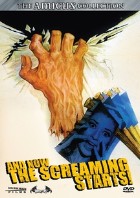
A rival to Hammer, Amicus developed a unique identity by placing the majority of its cinematic nightmares in the present, something that Hammer only started to do in such Johnny-come-lately fare as Dracula A.D. 1972. But in the early Seventies Amicus did its own round-about, temporarily abandoning its focus on the present to find fear in the past. Invading Hammer territory, And Now The Screaming Starts looks very much like a Hammer film. While several critics resist its dark charms, both the story and its direction evoke an undeniable sense of doom. Fine performances and nightmarish atmosphere evoke a lively sense of infectious terror. Speaking to modern audiences with surprisingly adult themes of familial crime and rape, this sensational story is nevertheless rooted in a beautifully captured past of gingerbread Faerie-Tale sensibilities.
Directed by the unerringly professional, workman-like Roy Ward Baker, a director who contributed some of the seventies finest if oft-neglected fright films with taste, daring, and intelligence, And Now The Screaming Starts was crafted between his work on the omnibus Amicus films for which he is primarily remembered. Often ranked behind fellow Hammer directors Terence Fisher and Freddie Francis, Baker weaved ominous nightmares with innovative camera work and intense atmospheric verve; despite occasional lapses of logic in the scripts he was often forced to use, his movies have a unique charm. Based on the supernatural novel Fengriffen, this visual feast of lush surrealism, lust, and occult re-occurrence is an uneven if worthwhile addition to traditional gothic horror. Nothing particularly new in terms of general theme, owing much of its suspense (and structure) to the revenge tragedies popular before even Shakespeare wielded a quill, the treatment of cyclic retribution, corruption, and possession is engaging and surprisingly exploitative.
Focusing on a feud between a corrupted land barren of yore and a balefully miss-used servant, this 18th century pot-boiler centers on young Charles Fengriffen (Ian Ogilvy), who brings his blushing bride Catherine (Stephanie Beacham) to the family estate in England. Upon setting foot in the centuries-old ancestral domain, Catherine suffers visions which are themselves linked to a foreboding portrait of Charles's grandfather Henry (Herbert Lom). Soon enough, the lovely Catherine believes that a specter with blood pouring from his eye-sockets is keeping tabs on her; she is rapped by an apparition on her wedding night, and the entire household soon finds themselves menaced by a disembodied hand. Not always a strong point with Amicus, characterization is emphasized herein, the length and complexity of the story allowing for a heated, emotionally abusive interplay between husband and wife. Present and past also weave a macabre spell. Charles refuses to reveal the tragic past of his family or his suspicions to Catherine, who sinks into helplessness with each passing night. A deadly, haunting back-story of debts, damnation, and conspiracy provides a sinister backdrop to an already frightful tale of spectral rage. When Catherine discovers she's pregnant, she breaks down. This supernatural tale of cuckolding and 'the sins of the father' being visited upon the 'son' (through, it seems, the woman gets the worst of it all) is both intelligent and subversive for its time. Discovering that her ghostly attacker resembles the woodsman Silas (Geoffrey Whitehead), Catherine receives little aid from the family doctor (Patrick Magee), a fellow with secrets of his own. Peter Cushing is called in as a specialist to investigate the case as mesmerizing flash-backs reveal the family's haunted past.
A definitive change of departure from their anthology films, Amicus gathers the talents of Baker, Cushing, Lom and Magee for a story equal parts psychological attack and Gothic sensationalism, complete with antiquated setting, desperate heroines, and supernatural curses. The past is just as much a character as the cast, intruding upon the present and threatening the future of innocents. This invites audiences to experience pathos and catharsis, making And Now The Screaming Starts a lovely piece of period filmmaking and an ode to singularly contemporary problems of identity. Baker's direction is inspired as he uses the camera to tell the story, and the performances are surprisingly serious in scenes where such silly devices as crawling hands (Amicus sure loved crawling body parts!) and leering portraits could easily have invited laughter instead of shudders. While the problem of pedestrian effects and over-emphasized stock conventions somewhat hampers the level of intensity in certain scenes, the obvious dedication and good nature that flows through the production makes it shamelessly enjoyable.
A new Hi-Def 16x9 1.85:1 Anamorphic Widescreen Transfer (from a 35mm negative) presents the film in as good a condition as you'll ever see it, lending richness to colors and clarity to images. The audio is also commendable, featuring 2.0 mono. Even more generous are extras that encourage richer appreciation of the cultural context, individual artistry, and unified effort that went into the production. This heaping helping of supplementary havoc includes a commentary by director Roy Ward Baker & actor Stephanie Beacham, and a second track by actor Ian Ogilvy (moderated by Darren Gross). Following these are trailers for "And Now The Screaming Starts," "Asylum," and "The Beast Must Die," the obligatory Still Gallery, Bios for Baker, Beacham, Ogilvy, Peter Cushing, Herbert Lom, Milton Subotsky & Max J. Rosenberg, and, finally, Liner Notes. A bloody good treat for fear-fans, this horror show of cuckolding curses in dreary Old England is an example of Gothic greatness that no longer exists.
Review by William P Simmons
| Released by Dark Sky |
| Region 1 NTSC |
| Not Rated |
| Extras : see main review |